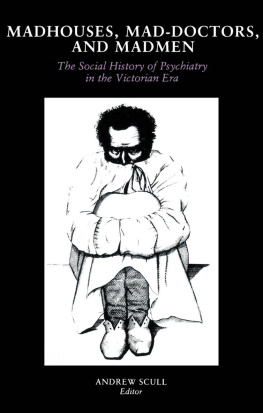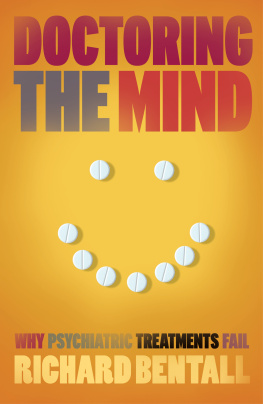Contents
Guide
Pagebreaks of the print version
Desperate Remedies
PSYCHIATRYS TURBULENT QUEST TO CURE MENTAL ILLNESS
ANDREW SCULL
THE BELKNAP PRESS OF HARVARD UNIVERSITY PRESS
Cambridge, Massachusetts 2022
Copyright 2022 by Andrew Scull
Published in the United Kingdom as Desperate Remedies: Psychiatry and the Mysteries of Mental Illness by Allen Lane, an imprint of Penguin Books Ltd., a Penguin Random House Company.
All rights reserved
Cover design: Marina Drukman
978-0-674-27646-8 (EPUB)
978-0-674-27647-5 (PDF)
978-0-674-26510-3 (HARDCOVER)
The Library of Congress has cataloged the printed edition as follows:
Names: Scull, Andrew, 1947- author.
Title: Desperate remedies : psychiatrys turbulent quest to cure mental illness / Andrew Scull.
Description: Cambridge, Massachusetts : The Belknap Press of Harvard University Press, 2022. | Includes bibliographical references and index.
Identifiers: LCCN 2021047502
Subjects: LCSH: Mental illnessTreatmentUnited StatesHistory. | PsychiatryUnited StatesHistory. | Psychiatric ethics United StatesHistory.
Classification: LCC RC443 .S394 2022 | DDC 362.20973dc23/eng/20211008
LC record available at https://lccn.loc.gov/2021047502
This book is dedicated to the memory of our son, Alexander Anthony Scull (19902016), greatly missed every day.
CONTENTS
FEW OF US ESCAPE THE RAVAGES OF MENTAL ILLNESS. We may not suffer from it ourselves, but even then we feel the pain it inflicts on friends or family. And no one escapes its social burdens. Psychiatry seeks to lessen these afflictions, but too often it has increased them. In this book, I have attempted to provide a skeptical assessment of the psychiatric enterpriseits impact on those it treats and on society at large. I have focused most of my attention on the United States, because it is here that these interventions stand out in the starkest relief and because, by the closing decades of the twentieth century, American psychiatry had achieved a worldwide hegemony, its categorizations of and approaches to mental illness sweeping all before it. But many of the interventions I examine had their origins in Europe, including the drugs that are now so central to psychiatric identity and operations. So European developments loom large in this story and are woven through the narrative that follows.
For two centuries and more, most informed opinion has embraced the notion that disturbances of reason, cognition, and emotionthe sorts of things we used to gather under the umbrella of madnessproperly belong in the domain of the medical profession. More precisely, such maladies are seen to be the peculiar province of those whom we now call psychiatrists. Mental illness, we are informed, is an illness like any otherone that is treated by a specialist group of doctors whose primary goals are to relieve suffering and, more ambitiously, to restore the alienated to the ranks of the sane. These are worthy goals, to be sure. How have psychiatrists sought to realize them? How have psychiatrists attacked the problem of mental illness? What weapons have they chosen and why? And have those treatments succeeded in relieving suffering and curing those consigned to psychiatrists tender mercies? These are the central questions I propose to explore in the pages that follow.
My focus is on the therapeutics of mental illness and on the professionals who advanced them. But I seek constantly to keep in mind that these interventions are not abstractions but rather organized forms of action carried out upon our fellow human beings. Patients are the constant subtext of my story. They are the people whose bodies and minds are subjected to each of these therapiessometimes several of them successivelyand not always with success.
Psychiatry emerged in the nineteenth century as a specialized branch of medicine claiming expertise in the management and cure of what was then called insanity or lunacy. Psychiatrys rise was intimately linked to the emergence of the asylum, and for a long time psychiatry and the asylum were locked in a symbiotic embrace. Prior to the Civil War, these institutions housed an almost exclusively white population. When institutional provision for African Americans began to be provided after the war, it took the form of either segregated wards or entirely separate institutions for the colored insane.
Psychiatrys marginalization of the Black population was, of course, of a piece with the exclusion and discrimination they faced in the larger society, and in many ways such marginalization persists into the present. Racism continues to have an impact on life chances, whichever sector of society one attends to: the economy, housing, education, or the criminal justice system, to mention only some of the more obvious arenas. And, of course, with respect to healthboth mental and physicalwhere the cumulative disadvantages of poverty and racial prejudices are vividly demonstrated by, for example, data concerning maternal mortality and life expectancy.
Mental illness haunts us, frightens us, and fascinates us. Its depredations are a source of immense suffering and often embody threats, both symbolic and practical, to the very fabric of the social order. Ironically, the stigma that surrounds those who exhibit a loss of reason has often extended to those who have claimed expertise in its identification and treatment. Of all the major branches of medicine, psychiatry, throughout its history, has been the least respected, not just by those to whom it ministers but also by physicians and the public at large.
Vast resources have been devoted over time to efforts to intervene in, ameliorate, and perhaps cure the mysterious conditions that constitute mental disorder. Yet, two centuries after the psychiatric profession first struggled to be born, the roots of most serious forms of mental disorder remain as enigmatic as ever. The wager that mental pathologies have their roots in biology was firmly ascendant in the late nineteenth century, but that consensus was increasingly challenged in the decades that followed. Then, a little less than a half century ago, the hegemony of psychodynamic psychiatry rapidly disintegrated, and biological reductionism once again became the ruling orthodoxy. But to date, neither neuroscience nor genetics have done much more than offer promissory notes for their claims, as I shall show in later chapters. The value of this currency owes more to faith and plausibility than to much by way of widely accepted science.
For what it is worth, I should be astonished if several of the major varieties of mental disturbance do not turn out to be at least partially explained by biological factors. But I should be equally astonished if biology turns out to be the whole story. Indeed, in some respects I think the whole debate about nature versus nurture rests on a serious category mistake, because our brains are extraordinarily plastic organs, jointly constituted by the social and the physicalby the biological endowment we are born with and by the psychosocial environment within which our brains grow and develop, a point I shall return to in my conclusion.
But the fundamental point remains: the limitations of the psychiatric enterprise to date rest in part on the depths of our ignorance about the etiology of mental disturbances. Psychiatrys deficits also reflect the profound limitations of the treatments psychiatrists can offer patients even in our own times. For the most severe forms of mental disturbanceschizophrenia, bipolar disorder, and grave depressionswhich are the overwhelming focus of this book, it is important to be clear-eyed: not to deny that there has been some progress, but equally not to ignore the price that is sometimes paid for such relief as psychiatry can now provide. Periodically, as we shall see, enthusiasts have proclaimed that decisive breakthroughs are at hand or that miraculous cures have been discovered. To date, these supposed revolutions have proved evanescent and are often the harbinger of distinctly damaging interventions.









